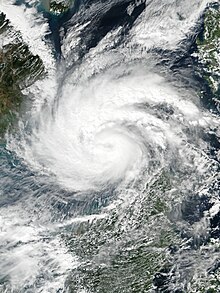 Tembin at peak intensity in the South China Sea on December 24 | |
| Meteorological history | |
|---|---|
| Formed | December 20, 2017 |
| Dissipated | December 26, 2017 |
| Typhoon | |
| 10-minute sustained (JMA) | |
| Highest winds | 130 km/h (80 mph) |
| Lowest pressure | 970 hPa (mbar); 28.64 inHg |
| Category 2-equivalent typhoon | |
| 1-minute sustained (SSHWS/JTWC) | |
| Highest winds | 155 km/h (100 mph) |
| Lowest pressure | 959 hPa (mbar); 28.32 inHg |
| Overall effects | |
| Fatalities | 266 total |
| Damage | $42 million (2017 USD) |
| Areas affected | Palau, Philippines, Malaysia, Vietnam |
| IBTrACS | |
Part of the 2017 Pacific typhoon season | |
Typhoon Tembin, known in the Philippines as Typhoon Vinta, was the deadliest tropical cyclone to strike Mindanao since Typhoon Bopha in 2012. Following and impacting the Philippines less than a few days after the deadly Tropical Storm Kai-tak, Tembin, which means Libra in Japanese, the twenty-seventh named storm and the eleventh typhoon of the 2017 Pacific typhoon season. It was first classified as a weak tropical depression on December 16. The system gradually intensified and consolidated into a tropical storm on December 20. Tembin made landfall in Mindanao late the next day. On December 23, Tembin followed a path towards the South China Sea and intensified into a typhoon early the following day. Quick intensification ensued and Tembin reached its peak intensity as a low-end Category 2 typhoon as assessed by the Joint Typhoon Warning Center on December 24. Unfavorable conditions enhanced by the winter monsoon caused Tembin to rapidly weaken shortly afterwards, before it ultimately dissipated on December 26 while just south of Vietnam.
Tembin caused a total of 266 deaths,[1][2][3] five of which were from a sinking of a ferry due to rough seas caused by the storm.[4][5]
- ^ "Death toll from Tropical Storm Vinta breaches 200". Rappler. 23 December 2017. Retrieved December 24, 2017.
- ^ "Philippines: Deaths from typhoon Vinta more than 200". World Bulletin. December 24, 2017.
- ^ "Vinta death toll climbs to 240, scores missing". Rappler. December 25, 2017.
- ^ "Search for ferry accident survivors continues, 5 dead". ABS CBN. December 22, 2017.
- ^ "Death toll from Tropical Storm Vinta breaches 100". Rappler. December 23, 2017.